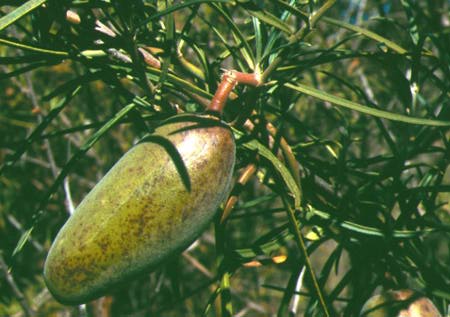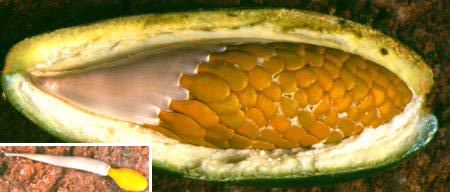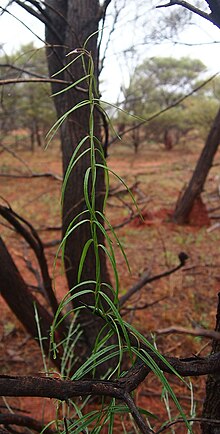Marsdenia australis
Bush banana ( Marsdenia australis)
The bush banana ( Marsdenia australis, Syn: Leichhardtia australis R.Br. ) is a species in the subfamily of the milkweed family ( Asclepiadoideae ) within the family of the dogbane family ( Apocynaceae ). The occurring only in Australia species grows in Central Australia and throughout Western Australia. Parts of plants of banana bush were a so-called Bush food an important food which mainly eat the living in the bush Aborigines.
Description
Marsdenia australis grows as a twining plant, reaching heights of growth of up to 4 meters. It forms nodules with diameters of up to 16 cm than outlasting. The bark on young stems is hairy fluffy, on older stems is rarely smooth. It is white milk juice available. The 2-15 mm long stalked leaves are of a length of usually 3 to 12 cm and a width of 2 to 8 mm 10 - to 18 - times longer than wide. They are very thick and somewhat fleshy with prominent midrib, usually with one to five tiny glands at its base.
Six to 19 flowers are borne in a stalked 3 to 15 mm long, doldigen inflorescence. 3 to 15 mm long stemmed flowers have a diameter of about 4 to 5 mm and are fünfzählig and green to yellow. The five sepals are 2-4 mm long. The five 6-8 mm long, egg-shaped petals are fused with 3 to 4 mm long Kronlappen. The flowering period extends from late spring to summer.
The thick-walled, hairless follicles have a length of 4 to 10 cm and a diameter of 2.5 to 3.5 cm. The head of hair of the seeds is 20 to 40 mm long.
Etymology
The genus name honors William Marsdenia Marsden (1754-1836), an Irish orientalist and numismatist. The specific epithet australis is Latin and means south. The valid name Marsdenia australis ( R.Br. ) Druce she received in 1917 by George Claridge Druce in Bot Soc. Exch. Club Brit. Isles, 4, 634 The name Leichhardtia australis goes to the German explorers, zoologists, botanists and geologists Ludwig Leichhardt ( 1813-1848 ) back. The first publication as Leichardtia australis was in 1849 by Robert Brown: Cogola Bush in Sturt, fool. Exped. Cents. Australasia, 2, App. . 81
English common names are Doubah, Native Pear, Australasia Doubah, Cogola Bush, bush banana, silky pear or green vine.
The bush banana has different names in the languages of the Aborigines. In the language of Arrernte in Central Australia it is called Merne alangkwe (older Transcription: Elonka ) Merne ulkantyerrknge (the flower) and Merne altyeye ( the prefix Merne called fruits of plants ). The plant can be eaten in the early as well as in the adult state. The small fruits are called amwerterrpe. The town of Kalgoorlie is named after the word of Wangai Aboriginal Karlkurla, the place of silky pears ( German: Place the silky pears) means.
Food
The bush banana spreads like wild wine from, hence the common name green vine, and climbs like wild wine on other plants high. The sweet-tasting flowers hang in bunches on the plant and are edible; for the Arrernte Aboriginal people are the most important part of the plant ( altyeye ).
Bush bananas are cooked in hot earth beside the fire or eaten raw in the early state (the taste is comparable to fresh peas). The roots of this plant are called Merne atnetye and can be eaten as raw or cooked. The color very white roots are boiled in hot earth beside the fire.
All parts of the bush banana are eaten today in the deserts of Australia. It is one of the most important edible plants for the Aborigines.
Art and Mythology
This edible plant is shown in the Aboriginal art, especially paintings of the bush tucker, as well as paintings in the so-called Bush Banana Dreamings of the Dreamtime. The plant has a totem for the Aboriginal people of great importance. Pictorial and symbolic representations painted as the Aboriginekünstler Christopher Japan Gardi Poulson / Yuparli Jukurrpa, Deidrie Napangardi Brown, Janet Forrester Ngala and Dorothy Abbott Napangardi.
Swell
- GJ Harden & JB William: New South Wales Flora Online: Marsdenia australis.










